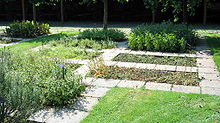
Back Groentetuin Afrikaans حصة حديقة Arabic Bostan Azerbaijani Daržos BAT-SMG ঘরোয়া বাগান Bengali/Bangla Jardí d'hort Catalan Пахча CV Køkkenhave Danish Küchengarten German Kuireja ĝardeno Esperanto


The traditional kitchen garden, vegetable garden, also known as a potager (from the French jardin potager) or in Scotland a kailyaird,[1] is a space separate from the rest of the residential garden – the ornamental plants and lawn areas. It is used for growing edible plants and often some medicinal plants, especially historically. The plants are grown for domestic use; though some seasonal surpluses are given away or sold, a commercial operation growing a variety of vegetables is more commonly termed a market garden (or a farm). The kitchen garden is different not only in its history, but also its functional design. It differs from an allotment in that a kitchen garden is on private land attached or very close to the dwelling. It is regarded as essential that the kitchen garden could be quickly accessed by the cook.

Historically, most small country gardens were probably mainly or entirely used as kitchen gardens, but in large country houses the kitchen garden was a segregated area, normally rectangular and enclosed by a wall or hedge, walls being useful for training fruit trees as well as offering shelter from wind.[2] Such large examples very often included greenhouses and furnace-heated hothouses for more tender delicacies, and also flowers for display in the house; an orangery was the ultimate type. In large houses, the kitchen garden was typically placed diagonally to the rear and side of the house, not impeding the views from the front and rear facades, but still quick to access. In some cases, hardy flowers for cutting were grown outside there, rather than in the flower garden. A large country house hardly expected to buy any vegetables, herbs or fruit, and the surplus was often distributed as presents; the walled example at Croome Court in England covers seven acres,[3] and the gardens have a large "Temple Greenhouse", an orangery in the form of a Roman Temple.
A symbol of American self-sufficiency and the colonial homestead, practical kitchen gardens were the center of home life in early America. In Europe, especially Britain, the difficulties in food supply during World War II resulted in a huge, if temporary, upsurge in growing vegetables in small gardens, with much encouragement from the government Ministry of Food. In modern gardening, there has been interest in integrating the growing of food plants within a mainly ornamental garden; fruit trees and cooking herbs are the simplest and most popular expression of this.[4]
- ^ Scots "kailyaird" or "kailyard", means a small cabbage patch (see kale) or kitchen garden, usually adjacent to a cottage.--Cuddon, J. A. (1977) A Dictionary of Literary Terms. London: André Deutsch; p. 343.
- ^ "Flower garden - History of Early American Landscape Design". heald.nga.gov. Retrieved September 22, 2023.
- ^ BBC News (August 23, 2014), Croome Court Georgian walled garden opens for first time, BBC
- ^ Cite error: The named reference
Alanwas invoked but never defined (see the help page).